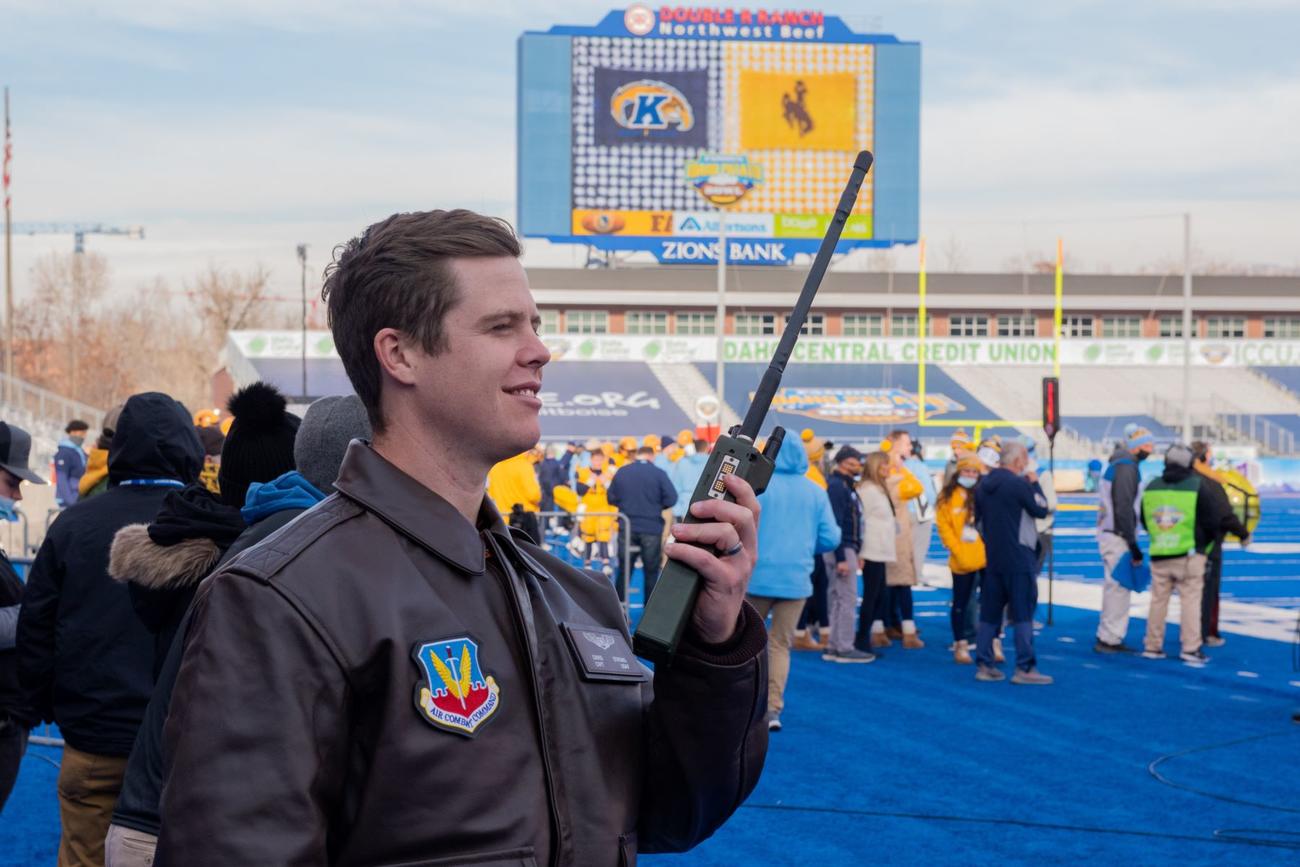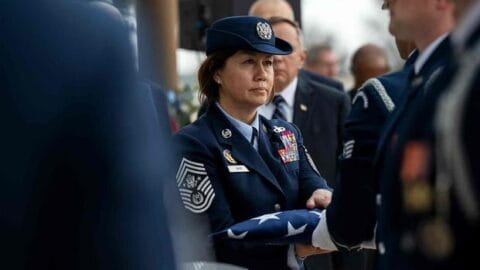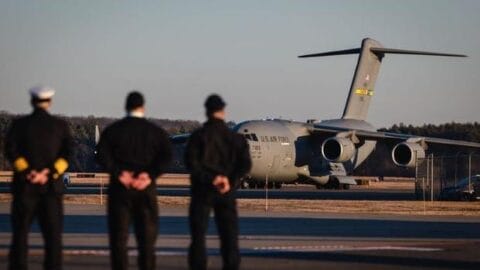
Alabama fans can’t get enough of gameday traditions from pregame tailgating to singing “Rammer Jammer” after another Crimson Tide win.
But the stadium flyover moments before kickoff is climbing the charts for Bryant-Denny Stadium rituals you must cross off your college football bucket list.
As you might imagine, each flyover performed by various military branches, comes with a lot of preparation before you see, hear and feel that whoosh overhead that gives you a heavy dose patriotism and jump-starts an unforgettable stadium atmosphere.
Morgan James, an assistant athletics director for marketing and fan development at UA, coordinates each gameday flyover.
He took us behind the scenes, revealing the thorough logistical planning and precision required each time.
The planning process for flyovers actually begins around June and July before each season.
UA must file paperwork for each event/game (Request for Military Support), which they submit online for approval. Once the paperwork is approved for each game, military units can reach out to the UA point of contact to book a specific game.
Once the flyover crew is booked for a specific game, UA works with them on game specifics that include flyover time, plus departure and arrival airport(s), game tickets, in-game recognition and any additional approvals or paperwork that may be needed.
James said only two of the 2022 season’s flight crews requested a “rehearsal.”
Some want to get get “a lay of the land” the day before the game, while others want to discuss any and all details they need to know before they execute the event.
“In my experience this year the majority of the crews that volunteer to do these flyovers have done flyovers before and don’t necessarily need a rehearsal but just the timing logistics of when we want them to fly over the stadium,” James said.
The 2022 season will have had four flyovers with flight crews from across the United States.
The crews work with local air bases or airports based on their jets to determine where they can take off and land, James said.
“We have had flight crews take off and land at Columbus, Miss., as well as land in Birmingham,” he said. “To my knowledge, it really depends on the flight crew and their communication with local air bases and FAA.”
How do they determine which type of aircraft will perform the flyover?
When UA submits the Request for Military Support paperwork at the beginning of the process, they request a Fixed Wing Jet, and then it depends on the flight crew that volunteers for each game and what their squadron flies.
Timing up the flyover is probably the hardest part of the whole process, James said. “We always try to have the flyover at the end of the national anthem but some times we have to adjust based on the rules and regulations around fly times. Flight crews cannot fly after sunset or dusk. “We have a pre-game timing sheet where everything is timed out and we try to get each pre-game element to the exact second.”
While they have it all timed out, external factors during pregame can affect the timing. Prior to the jets taking off from their location, UA communicates when the flyover is supposed to occur in real time.
There are two flight crew members on the ground, one in the production booth and one at the top of the stadium that are communicating with the pilots in real time to tell them if the timing of the flyover has changed.
“There is a certain point where the grounds crew and pilots can no longer talk and the jets will flyover the stadium no matter where we are at in timing,” James said.
For Austin Peay last week the 49th Fighter Training Squadron performed the flyover. For the Iron Bowl, which kicks off at 2:30 p.m. in Bryant-Denny Stadium, you’ll see the Marine Fighter Attack Squadron 115.
Each game, prior to the national anthem and flyover, UA honors a service member as a flag recipient and thank them for their service to our country.
“It’s an important tradition to honor our brave men and women who serve in our military,” James said. “After the flag recipient and national anthem, the flyover is a great way to cap off this pageantry and excite our fans for our country, our service members and Alabama football.”
After a few flyovers, you may have noticed some flight crew members unzipping the top of their suits to reveal a crimson and white T-shirt. Turns out, a few pilots have UA ties and a hand in making those special moments happen.
Capt. Austin Starks, a U.S. Air Force weapons systems officer (WSO) and UA graduate, participated in the Texas A&M flyover Oct. 8.
He contacted UA to request to do the flyover before they determined the date that worked best for both parties, as he completed all Air Force requirements and waivers.
Flying from Mountain Home Air Force Base in Idaho, the 391st Fighter Squadron flight crew would need to find a nearby base, plus hotels, rental cars and tanker support to help them travel.
Once Starks picked the crew members, he also arranged for maintenance support down South and developed a game plan for where the planes would hold in the air outside the stadium.
“The flyover itself is pretty scripted,” Starks said, noting they must maintain a certain altitude throughout the flight. They coordinate the time with UA marketing, arrange for personnel with radios inside the stadium to make sure it’s all still a go and to know when to leave the hold point.
The Texas A&M flyover was a little different in that it was not a national anthem flyover, due to the timing of that day’s sunset. The crew is not legally allowed to perform PR events after “civil twilight,” so the 7 p.m. kickoff (due to the CBS primetime television slot), they had to bump it up to 6:25 p.m.
Starks, a Baton Rouge native who attended UA in 2013-2017 (graduated with a degree in aerospace engineering) is a weapons systems office in the two-seater fighter jet, in this case the F-15 E Strike Eagles (similar to what you see in “Top Gun” movies).
Beyond his own tie to UA, his front seat pilot was Huntsville native Capt. Tyler Lannom.
“I knew it was going to be really cool,” Starks said about flying over his alma mater.
He said the flyover was an involved experience, constantly checking their timing, coordination, speed and altitude.
As a WSO during flights like these, he is a safety observer ensuring the planes are all safe and legal while putting on a show for fans. He said while the flight itself was fun, being inside Bryant-Denny Stadium made it that much better.
“When we got on to the field, it was surreal. That’s the only thing I can say about it,” he said. “It was the coolest night of my life for sure.”
And while UA recognizes each flight crew in the north end zone during a timeout after that game’s flyover, Starks said he and the crew treat it as more of a tribute to retired military members and their own families.
It’s also a tribute to the “red-blooded Americans” enjoying the show.
“Just the sound of afterburners hyping people up, all that power, all that noise, knowing we’ve got 1,000-times that ready to go. It’s a cool display, too. Being on the ground, seeing a handful of jets like that flying over. It gets people excited and makes people feel safe.”
Starks said he had the chance to tailgate on campus with his family before the game.
But, with about three hours to go before kickoff, he and the crew made the 80-minute drive to Meridian where they’d parked their jets before flying back to Tuscaloosa in just 10 minutes.
He said the jets held in the air for about 20 minutes before they got their cue and repositioned and executed the flyover in the span of about five minutes. After another 10-minute flight back to Meridian, they’d spent about 45 minutes in the air in total.
Show Full Article
© Copyright 2022 al.com. All rights reserved. This material may not be published, broadcast, rewritten or redistributed.
Tags: Air Force Air Force News Alabama BehindtheScenes Flyovers Football Games Happen Military Stadium Working Warriors








